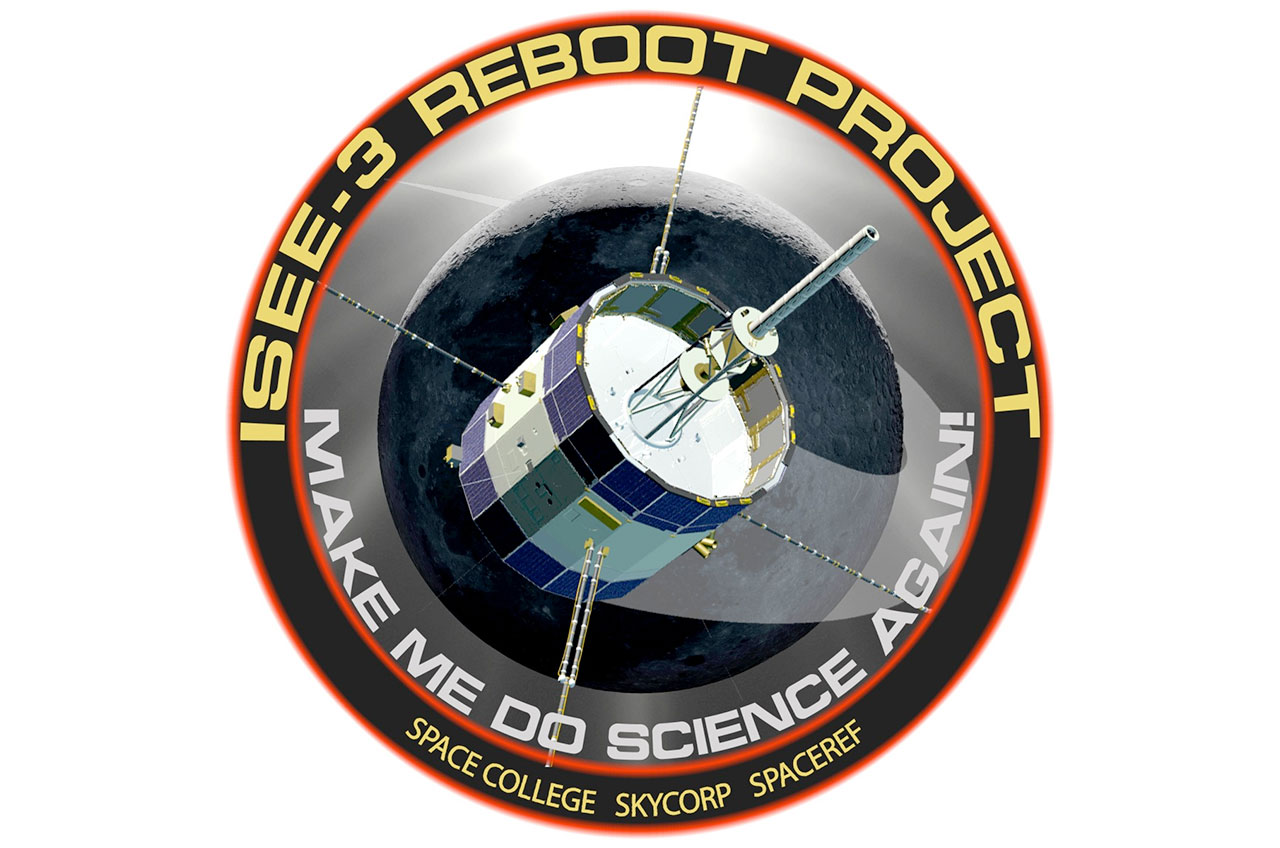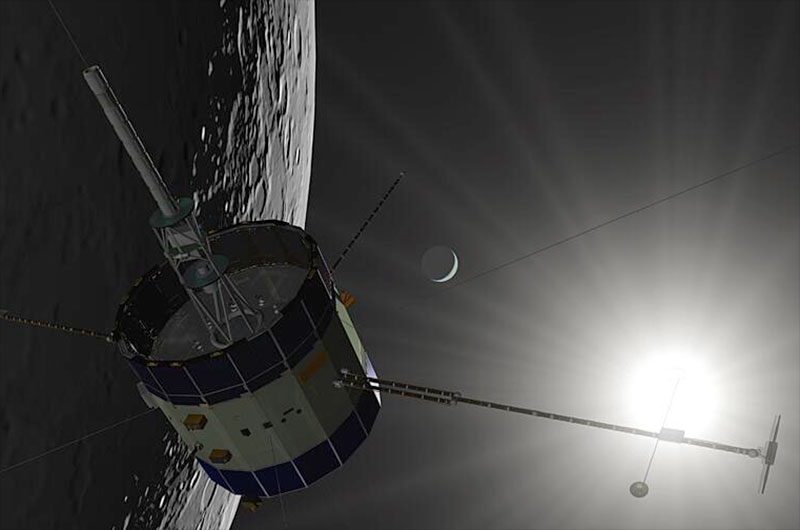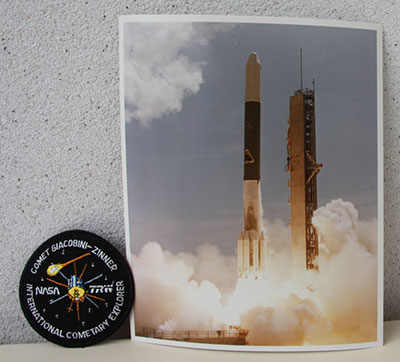|
|

|
|
Author
|
Topic: ISEE-3/ICE spacecraft: Reboot Project (2014)
|
Robert Pearlman
Editor Posts: 42988
From: Houston, TX
Registered: Nov 1999
|
 posted 05-22-2014 06:16 AM
posted 05-22-2014 06:16 AM
   
NASA release NASA Signs Agreement with Citizen Scientists Attempting to Communicate with Old SpacecraftNASA has given a green light to a group of citizen scientists attempting to breathe new scientific life into a more than 35-year old agency spacecraft. The agency has signed a Non-Reimbursable Space Act Agreement (NRSAA) with Skycorp, Inc., in Los Gatos, California, allowing the company to attempt to contact, and possibly command and control, NASA's International Sun-Earth Explorer-3 (ISEE-3) spacecraft as part of the company's ISEE-3 Reboot Project. This is the first time NASA has worked such an agreement for use of a spacecraft the agency is no longer using or ever planned to use again. The NRSAA details the technical, safety, legal and proprietary issues that will be addressed before any attempts are made to communicate with or control the 1970's-era spacecraft as it nears the Earth in August. "The intrepid ISEE-3 spacecraft was sent away from its primary mission to study the physics of the solar wind extending its mission of discovery to study two comets." said John Grunsfeld, astronaut and associate administrator for the Science Mission Directorate at NASA headquarters in Washington. "We have a chance to engage a new generation of citizen scientists through this creative effort to recapture the ISEE-3 spacecraft as it zips by the Earth this summer." Launched in 1978 to study the constant flow of solar wind streaming toward Earth, ISEE-3 successfully completed its prime mission in 1981. With remaining fuel and functioning instruments, it then was redirected to observe two comets. Following the completion of that mission, the spacecraft continued in orbit around the sun. It is now making its closest approach to Earth in more than 30 years.  The goal of the ISEE-3 Reboot Project is to put the spacecraft into an orbit at a gravitationally stable point between Earth and the sun known as Lagrangian 1 (L1). Once safely back in orbit, the next step would be to return the spacecraft to operations and use its instruments as they were originally designed. ISEE-3's close approach in the coming weeks provides optimal conditions to attempt communication. If communications are unsuccessful, the spacecraft will swing by the moon and continue to orbit the sun. NASA has shared technical data with these citizen scientists to help them communicate with and return data from ISEE-3. The contributions of any citizen science provided by the spacecraft, if it is successfully recovered, depend on the current condition of its instruments. New data resulting from the project will be shared with the science community and the public, providing a unique tool for teaching students and the public about spacecraft operations and data gathering. The data also will provide valuable information about the effects of the space environment on the 36-year old spacecraft. The ISEE-3 mission opened new pathways for scientific exploration, helping scientists better understand the sun-Earth system, which at its most turbulent can affect satellites around Earth and disrupt our technological infrastructure. |
Robert Pearlman
Editor Posts: 42988
From: Houston, TX
Registered: Nov 1999
|
 posted 05-22-2014 06:18 AM
posted 05-22-2014 06:18 AM
   
collectSPACE Saving a space probe: Private team seeks to revive abandoned NASA spacecraftA more than 35-year-old spacecraft that NASA once thought might be returned from space and put into the Smithsonian may instead soon resume its original mission thanks to the efforts of a private group. The International Sun-Earth Explorer 3 (ISEE-3) originally launched in 1978 to study solar wind before being diverted to chase after comets in the mid-1980s. Orbiting the sun ever since, it is now making its long-anticipated return to the vicinity of the Earth, where a newly-crowdfunded effort is gearing up to "reboot" the probe into service.  |
Glint
Member Posts: 1040
From: New Windsor, Maryland USA
Registered: Jan 2004
|
 posted 05-22-2014 02:57 PM
posted 05-22-2014 02:57 PM
   
It's nice to see that Bob Farquhar has a good hobby and hasn't lost his sense of humor. He's also making good on his promises from almot 30 years ago.In 1985, as ICE was racing to Comet P/Giacobini-Zinner to be the first spacecraft to visit a comet ahead of the international "armada" heading to the mainstream comet P/Halley, I was lucky enough to convince Bob to give a public lecture about the mission. During his talk, he explained how the entire mission was being paid in its entirety with only US$3M, and he was helping American tax payers to not only save face but several US$B's as well following cancellation of the Halley Intercept Mission (HIM). Farquhar promised that if he received more funding, he would return the spacecraft to its owners and would leave it where he found it in the first place -- at the earth's L-1 point. He went on to say that with additional funding, he could nudge it back into low earth orbit where it could be retrieved by the space shuttle and placed in the Smithsonian for all to enjoy. |
Apollo-Soyuz
Member Posts: 1205
From: Shady Side, Md
Registered: Sep 2004
|
 posted 05-24-2014 11:57 AM
posted 05-24-2014 11:57 AM
   
Here are scans of two covers depicting ISEE-3's early history. 
|
Robert Pearlman
Editor Posts: 42988
From: Houston, TX
Registered: Nov 1999
|
 posted 05-26-2014 05:18 AM
posted 05-26-2014 05:18 AM
   
According to an update posted by the ISEE-3 Reboot Project, the spacecraft is not exactly where NASA thought it to be. ...we now know that the spacecraft is off course compared to the existing ephemeris.The error in position has just elevated the concern level greatly. We know approximately what the offset error is from the existing ephemeris but we don't have enough information yet to plot a new course and generate a new ephemeris file. This has become extremely important as there is a solid statistical chance that the spacecraft could impact the moon or even be off course enough to threaten other spacecraft in Earth orbit. |
Philip
Member Posts: 5952
From: Brussels, Belgium
Registered: Jan 2001
|
 posted 05-27-2014 07:28 AM
posted 05-27-2014 07:28 AM
   
Nice to see some items from 1978. Here's the NASA photo of the ISEE-3 launch on Delta 144 on 12th August 1978.NASA photo 78-HC-455 and I have included a TRW patch on the 1978 project which performed the first comet encounter with Giacobini-Zinner and flew on to study Halley's comet. Interesting: NASA donated the spacecraft to the Smithsonian Institution for display following its possible recovery in the summer of 2014...  |
Robert Pearlman
Editor Posts: 42988
From: Houston, TX
Registered: Nov 1999
|
 posted 05-29-2014 03:20 PM
posted 05-29-2014 03:20 PM
   
The ISEE-3 Reboot Project has successfully established two-way communication with the satellite. The ISEE-3 Reboot Project is pleased to announce that our team has established two-way communication with the ISEE-3 spacecraft and has begun commanding it to perform specific functions. Over the coming days and weeks our team will make an assessment of the spacecraft's overall health and refine the techniques required to fire its engines and bring it back to an orbit near Earth.First Contact with ISEE-3 was achieved at the Arecibo Radio Observatory in Puerto Rico. |
Robert Pearlman
Editor Posts: 42988
From: Houston, TX
Registered: Nov 1999
|
 posted 06-13-2014 05:35 PM
posted 06-13-2014 05:35 PM
   
An update from the ISEE-3 Reboot Project: We have received confirmation from NASA that we have been confirmed for time on the DSN (Deep Space Network) for two-way Doppler and ranging activities with the ISEE-3 spacecraft. This is being done so as to determine the location of ISEE-3 with great precision for navigation purposes. Based on this data we will conduct our course correction engine firing. We have moved that original firing date from 17 June to a window that currently covers 30 June and 2 Juy. As the DSN ranging data comes in that window will shrink. DSN ranging passes after the engine burn will help us calculate the result of that burn and the new trajectory that ISEE-3 is pursuing.These DSN passes have been scheduled for 18 and 22 June, and 3, 4, 6 July. |
Headshot
Member Posts: 864
From: Vancouver, WA, USA
Registered: Feb 2012
|
 posted 06-13-2014 06:01 PM
posted 06-13-2014 06:01 PM
   
Both the LOIRP and this ISEE-3 Reboot Project are amazing. |
Robert Pearlman
Editor Posts: 42988
From: Houston, TX
Registered: Nov 1999
|
 posted 06-20-2014 02:19 PM
posted 06-20-2014 02:19 PM
   
Update from the ISEE-3 Reboot Project: We had to scrub ISEE-3 spin-up burn for today. We can't confirm receipt of commands in real time by the spacecraft. If we cannot confirm that proper commands were sent to the propulsion system we cannot fire thrusters with full confidence. Remember: this spacecraft does not have a computer. All 21 dummy commands worked — that should NOT have happened. Next time we sent them only three were accepted. Investigating... |
Robert Pearlman
Editor Posts: 42988
From: Houston, TX
Registered: Nov 1999
|
 posted 07-03-2014 07:24 AM
posted 07-03-2014 07:24 AM
   
Update from the ISEE-3 Reboot Project: [On July 2] we fired the A and B thrusters on ISEE-3 to perform a spin-up burn. Preliminary results confirm the burn and a change in rotation. Spin rate was originally 19.16 rpm. It is now at 19.76 rpm. The original mission specifications call for 19.75 +/- 0.2 rpm- so we are exactly where we wanted to be.We are now collecting telemetry in advance of our next DSN pass and our ATP-3 review with NASA. The earliest we expect to make our Trajectory Correction Maneuver is next week. |
Robert Pearlman
Editor Posts: 42988
From: Houston, TX
Registered: Nov 1999
|
 posted 07-09-2014 08:35 PM
posted 07-09-2014 08:35 PM
   
The project has run into problems executing the trajectory correction maneuver. We managed to conduct the first segment (composed of 63 thruster pulses) but encountered problems with the second and halted the remainder of segment firings. As of earlier today (July 9), the team was troubleshooting the problem(s). We do not think any of the valves are malfuctioning. Right now we think there is a chance that the Nitrogen used as a pressurant for the monopropellant Hydrazine propulsion system may have been depleted. That said, we still have a number of troubleshooting options yet to be explored. We have a DSN pass scheduled for Friday that will allow us to recalibrate our location information and trajectory plans for ISEE-3. Even if the L-1 halo orbit is no longer an option, we do have plans to use ISEE-3 for science in other locations within the inner solar system after the lunar flyby on 10 August. Space News reported that ISEE-3 will not be resuming its original mission. "We've done our best, but we're now looking at a flyby," said Cowing. Controllers at the ISEE-3 Reboot Project's main ground system at the Arecibo radio observatory in Puerto Rico have switched the craft over into science mode, which will allow its instrument to collect and beam data back to Earth for as long as anyone is willing to listen for it.Practically speaking, that will be about three more months, Cowing said. After that, the spacecraft will have traveled so far away from Earth that communicating with it will require receiving stations so large that the expense would simply not be worth it. |
Robert Pearlman
Editor Posts: 42988
From: Houston, TX
Registered: Nov 1999
|
 posted 07-24-2014 11:55 AM
posted 07-24-2014 11:55 AM
   
ISEE-3 Reboot Project release Announcing the ISEE-3 Interplanetary Citizen Science MissionAfter a successful reawakening the venerable ISEE-3 spacecraft is about to begin the first interplanetary citizen science mission. In April 2014 our team set about bringing the 36 year old ISEE-3 (International Sun Earth Explorer 3) spacecraft back into science operations. Our plan was to contact the spacecraft, evaluate its health, command it to resume normal operations, fire its engines, and resume the orbit it originally occupied in 1978. Once science operations resumed, our plan was to make the data openly available to citizen scientists - in fact, anyone, anywhere - as soon as we received it from the spacecraft. This task required the ISEE-3 Reboot Team to recreate hardware, software, and documentation that had been discarded decades ago, reassemble it into a operational form, organize an international mission team of volunteer scientists and engineers, raise all of our own funds (privately) to do all this, and then implement a rescue and reboot attempt within a matter of weeks. NASA gave us the green light and we successfully took command of ISEE-3 just 6 weeks after we began our project. We then brought its basic systems back online for the first time in decades. Shortly, the spacecraft will resume science operations with the half dozen science experiments that are still operational. We have completely accomplished all of our original goals except for one: firing the ISEE-3 propulsion system in a sufficient fashion to alter its trajectory. We did operate the propulsion system briefly so as to correct the spin of the spacecraft, and to start the trajectory correction maneuver. The propulsion system works fine. The problem is that there is no longer any Nitrogen pressurant left in its tanks to allow it to work. 36 years and more than 30 billion miles have taken its toll on the spacecraft's propulsion system. We have exhausted every option to bring the engines online so as to conduct the correction maneuver required to place it in its planned orbit. Without the pressurant it just won't work. While our original goal was to place ISEE-3 in a L-1 "halo" orbit, it will now do a flyby of the Moon and resume an orbit around the sun - an orbit nearly identical to Earth's. We have begun the process of shutting down systems that are no longer needed and reconfiguring ISEE-3 to maximize science operations. We are also implementing plans that will allow us to listen to its science data no matter where it goes. We will be beginning the "ISEE-3 Interplanetary Citizen Science Mission" on 10 August 2014 as the spacecraft flies by the Moon. We have a functional space craft that can do science and is already returning new data. All of our original citizen science objectives remain unchanged and are ready for implementation. In fact, we'll be announcing some new partnerships shortly that will serve to turbocharge our efforts in this regard. This will be the first citizen science, crowd funded, crowd sourced, interplanetary space science mission. A more detailed summary of recent activities and our partnership team will be posted here. This project would not have been possible without the help of many people and organizations around the world. Most notably (a partial list) the alumni of the ISEE-3/ICE mission, NASA Solar System Exploration Research Virtual Institute, NASA Deep Space Network, Arecibo Observatory, AMSAT-DL, Bochum Observatory, SETI Institute, Kinetix, Ettus Research, Space Exploration Engineering, Applied Defense, Dirk Fisher Electronics, National Instruments, AR Research, SpaceRef Interactive, Skycorp Inc, Space College Foundation, Morehead State University, NASA Science Mission Directorate, NASA Ames Research Center, NASA Headquarters, and the National Science Foundation. We would also like to thank everyone we have not mentioned who has participated in phase one of this paradigm shifting project and look forward to many years of science data from a newly rebooted ISEE-3. Most importantly we want to thank our 2,238 donors who invested $159,602 on our team's crazy idea. Your spacecraft is now ready to "do science again". | |
Contact Us | The Source for Space History & Artifacts
Copyright 2020 collectSPACE.com All rights reserved.

Ultimate Bulletin Board 5.47a
|
|

|
 advertisement advertisement

|
















